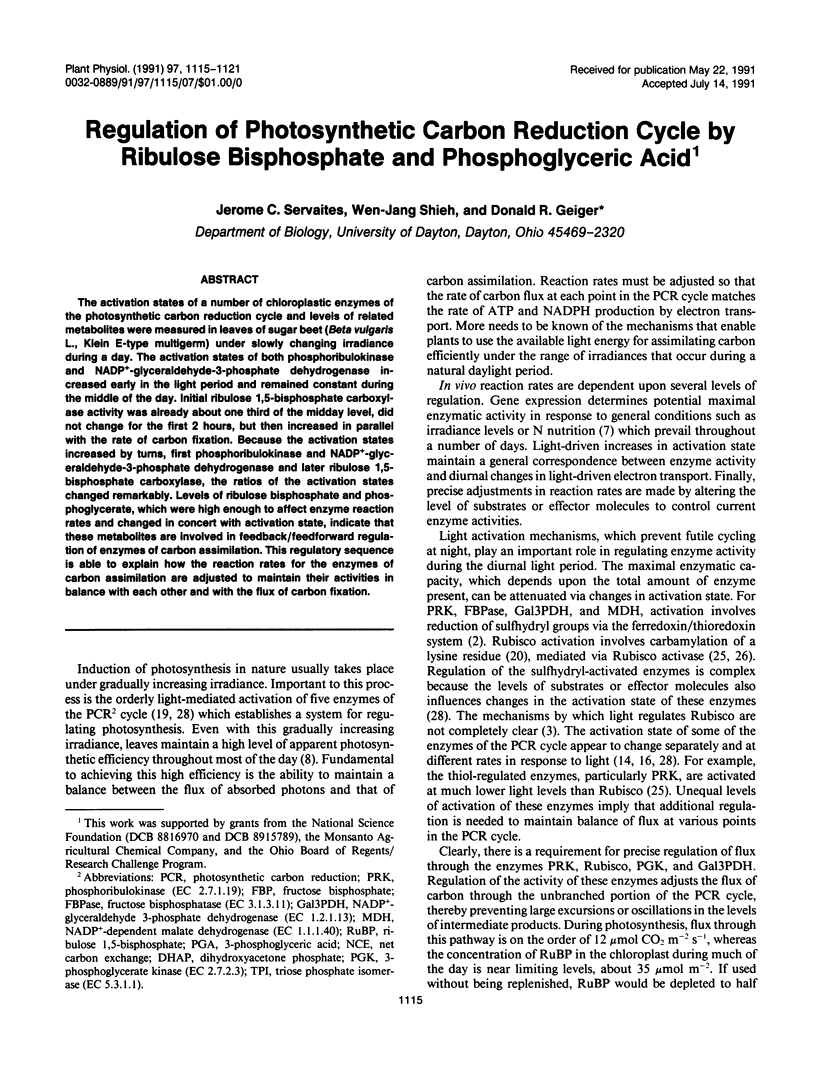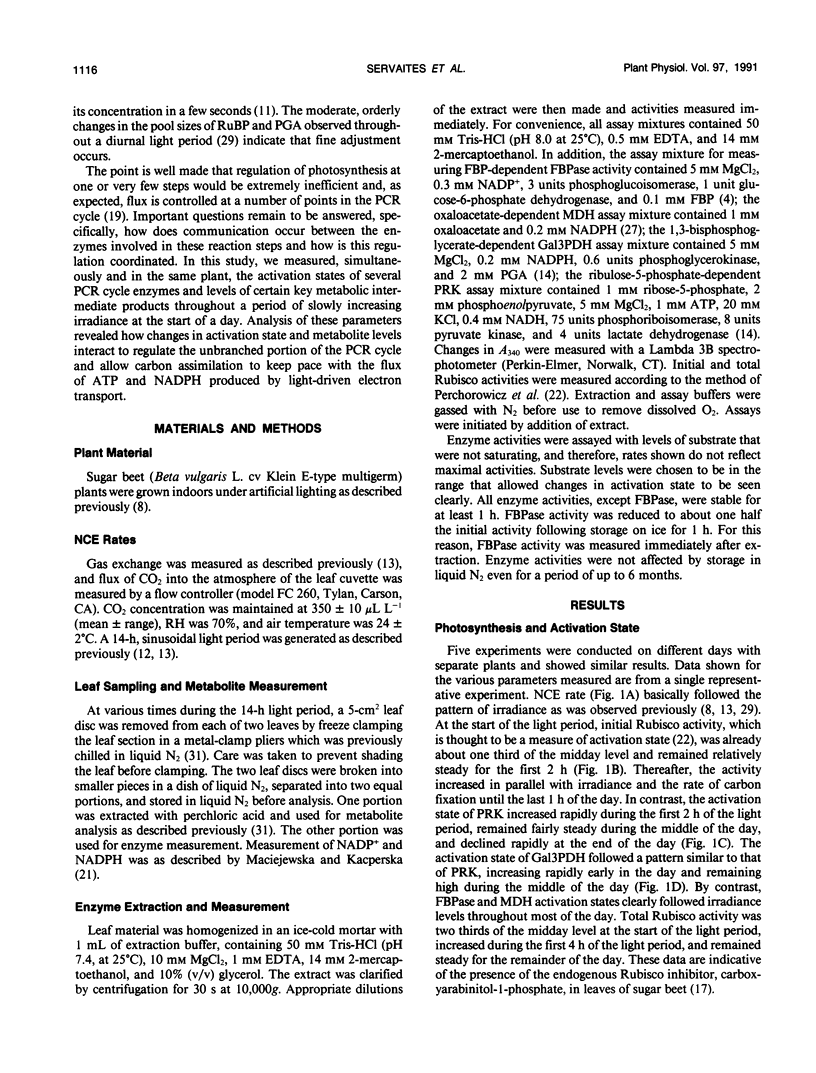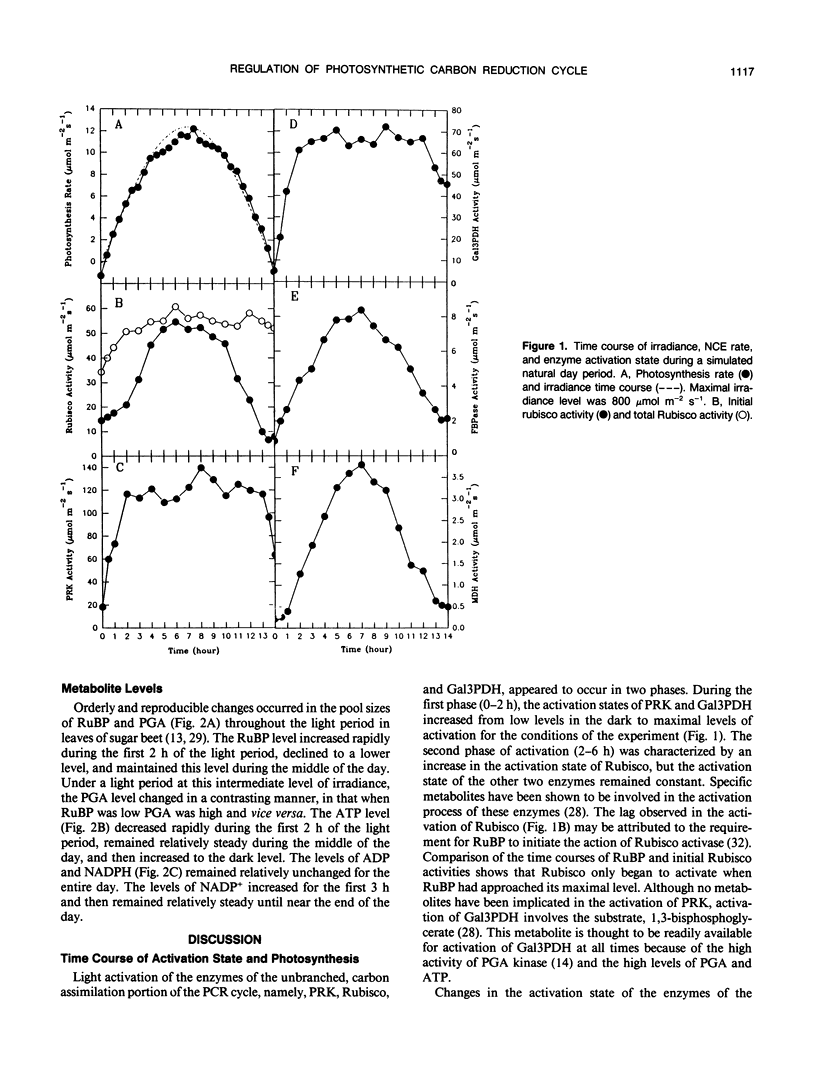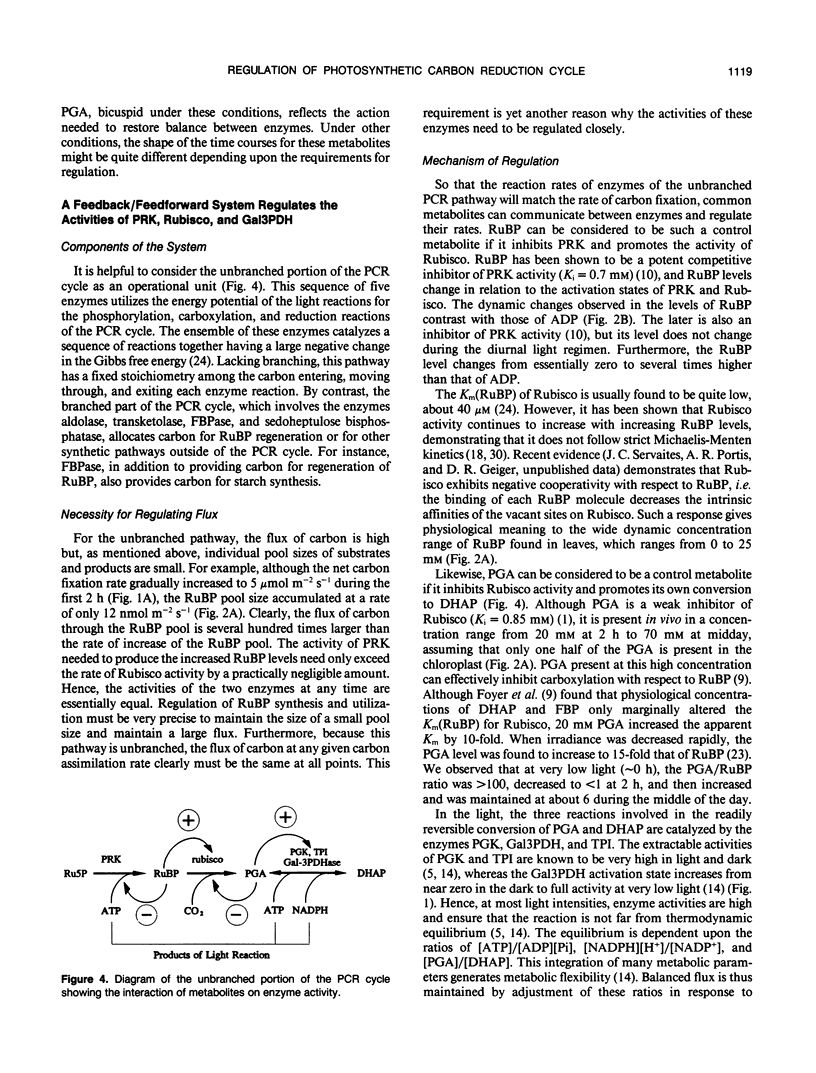Abstract
The activation states of a number of chloroplastic enzymes of the photosynthetic carbon reduction cycle and levels of related metabolites were measured in leaves of sugar beet (Beta vulgaris L., Klein E-type multigerm) under slowly changing irradiance during a day. The activation states of both phosphoribulokinase and NADP+-glyceraldehyde-3-phosphate dehydrogenase increased early in the light period and remained constant during the middle of the day. Initial ribulose 1,5-bisphosphate carboxylase activity was already about one third of the midday level, did not change for the first 2 hours, but then increased in parallel with the rate of carbon fixation. Because the activation states increased by turns, first phosphoribulokinase and NADP+-glyceraldehyde-3-phosphate dehydrogenase and later ribulose 1,5-bisphosphate carboxylase, the ratios of the activation states changed remarkably. Levels of ribulose bisphosphate and phosphoglycerate, which were high enough to affect enzyme reaction rates and changed in concert with activation state, indicate that these metabolites are involved in feedback/feedforward regulation of enzymes of carbon assimilation. This regulatory sequence is able to explain how the reaction rates for the enzymes of carbon assimilation are adjusted to maintain their activities in balance with each other and with the flux of carbon fixation.
Full text
PDF






Selected References
These references are in PubMed. This may not be the complete list of references from this article.
- Badger M. R., Lorimer G. H. Interaction of sugar phosphates with the catalytic site of ribulose-1,5-bisphosphate carboxylase. Biochemistry. 1981 Apr 14;20(8):2219–2225. doi: 10.1021/bi00511a023. [DOI] [PubMed] [Google Scholar]
- Campbell W. J., Ogren W. L. A novel role for light in the activation of ribulosebisphosphate carboxylase/oxygenase. Plant Physiol. 1990 Jan;92(1):110–115. doi: 10.1104/pp.92.1.110. [DOI] [PMC free article] [PubMed] [Google Scholar]
- Fondy B. R., Geiger D. R., Servaites J. C. Photosynthesis, Carbohydrate Metabolism, and Export in Beta vulgaris L. and Phaseolus vulgaris L. during Square and Sinusoidal Light Regimes. Plant Physiol. 1989 Feb;89(2):396–402. doi: 10.1104/pp.89.2.396. [DOI] [PMC free article] [PubMed] [Google Scholar]
- Geiger D. R., Fondy B. R., Tucci M. A. A Method for Calculating Sucrose Synthesis Rates throughout a Light Period in Sugar Beet Leaves. Plant Physiol. 1988 Jul;87(3):776–780. doi: 10.1104/pp.87.3.776. [DOI] [PMC free article] [PubMed] [Google Scholar]
- Geiger D. R., Shieh W. J., Lu L. S., Servaites J. C. Carbon Assimilation and Leaf Water Status in Sugar Beet Leaves during a Simulated Natural Light Regimen. Plant Physiol. 1991 Nov;97(3):1103–1108. doi: 10.1104/pp.97.3.1103. [DOI] [PMC free article] [PubMed] [Google Scholar]
- Kacser H., Burns J. A. The control of flux. Symp Soc Exp Biol. 1973;27:65–104. [PubMed] [Google Scholar]
- Kobza J., Seemann J. R. Regulation of ribulose-1,5-bisphosphate carboxylase activity in response to diurnal changes in irradiance. Plant Physiol. 1989 Mar;89(3):918–924. doi: 10.1104/pp.89.3.918. [DOI] [PMC free article] [PubMed] [Google Scholar]
- Laing W. A., Christeller J. T. A steady-state kinetic study on the catalytic mechanism of ribulose bisphosphate carboxylase from soybean. Arch Biochem Biophys. 1980 Jul;202(2):592–600. doi: 10.1016/0003-9861(80)90466-x. [DOI] [PubMed] [Google Scholar]
- Lorimer G. H., Badger M. R., Andrews T. J. The activation of ribulose-1,5-bisphosphate carboxylase by carbon dioxide and magnesium ions. Equilibria, kinetics, a suggested mechanism, and physiological implications. Biochemistry. 1976 Feb 10;15(3):529–536. doi: 10.1021/bi00648a012. [DOI] [PubMed] [Google Scholar]
- Perchorowicz J. T., Raynes D. A., Jensen R. G. Light limitation of photosynthesis and activation of ribulose bisphosphate carboxylase in wheat seedlings. Proc Natl Acad Sci U S A. 1981 May;78(5):2985–2989. doi: 10.1073/pnas.78.5.2985. [DOI] [PMC free article] [PubMed] [Google Scholar]
- Schürmann P., Jacquot J. P. Improved in vitro light activation and assay systems for two spinach chloroplast enzymes. Biochim Biophys Acta. 1979 Aug 15;569(2):309–312. doi: 10.1016/0005-2744(79)90067-6. [DOI] [PubMed] [Google Scholar]
- Servaites J. C., Geiger D. R., Tucci M. A., Fondy B. R. Leaf Carbon Metabolism and Metabolite Levels during a Period of Sinusoidal Light. Plant Physiol. 1989 Feb;89(2):403–408. doi: 10.1104/pp.89.2.403. [DOI] [PMC free article] [PubMed] [Google Scholar]
- Servaites J. C., Torisky R. S. Activation state of ribulose bisphosphate carboxylase in soybean leaves. Plant Physiol. 1984 Mar;74(3):681–686. doi: 10.1104/pp.74.3.681. [DOI] [PMC free article] [PubMed] [Google Scholar]
- Servaites J. C., Tucci M. A., Geiger D. R. Glyphosate effects on carbon assimilation, ribulose bisphosphate carboxylase activity, and metabolite levels in sugar beet leaves. Plant Physiol. 1987 Oct;85(2):370–374. doi: 10.1104/pp.85.2.370. [DOI] [PMC free article] [PubMed] [Google Scholar]
- Streusand V. J., Portis A. R. Rubisco Activase Mediates ATP-Dependent Activation of Ribulose Bisphosphate Carboxylase. Plant Physiol. 1987 Sep;85(1):152–154. doi: 10.1104/pp.85.1.152. [DOI] [PMC free article] [PubMed] [Google Scholar]


